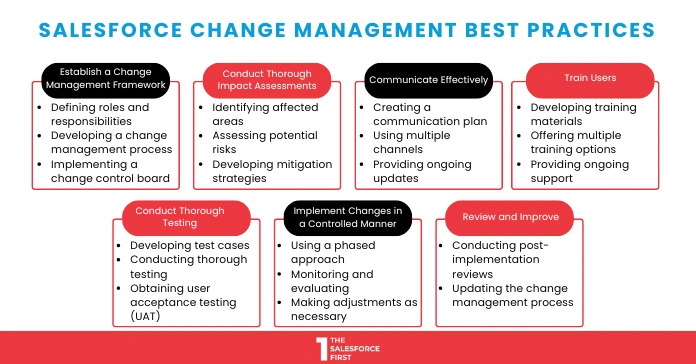This comprehensive guide will delve into the essential Salesforce change management best practices that organizations can adopt to ensure successful implementations, minimize disruption, and maximize the benefits of their Salesforce investments. By following these guidelines, you can streamline your change processes, reduce risks, and enhance user adoption.
Table of Contents
What is Salesforce Change Management?
Salesforce Change Management is a structured approach to implementing changes to your Salesforce organization while minimizing disruption and ensuring that the new processes or features are adopted effectively. It involves a series of steps to plan, communicate, test, and deploy changes in a controlled manner.
Why is Salesforce Change Management important?
- Minimizes disruption: Effective change management helps to avoid unexpected issues and downtime.
- Ensures successful adoption: By involving users in the change process, you can increase buy-in and ensure that new features are used as intended.
- Maintains data integrity: Proper change management helps to prevent data loss or corruption.
- Improves user satisfaction: By implementing changes smoothly and efficiently, you can enhance user experience.
Benefits of Following Salesforce Change Management Best Practices
Adhering to best practices in Salesforce change management can significantly enhance the success of your implementation projects. Here are some key benefits:
- Reduced Risk of Errors: By following established procedures, you can minimize the risk of human errors that could lead to data loss or system instability.
- Improved Efficiency: Best practices can streamline the change management process, saving time and resources.
- Enhanced Data Quality: Consistent application of change management principles helps maintain data integrity and accuracy.
- Increased User Satisfaction: A well-managed change process can improve user experience and satisfaction by minimizing disruption and ensuring that changes are implemented effectively.
- Better Compliance: Adhering to best practices can help you maintain compliance with industry regulations and standards.
- Stronger Governance: A structured change management process provides a framework for governance and oversight, ensuring that changes are aligned with business objectives.
- Improved Return on Investment (ROI): By following best practices, you can maximize the value of your Salesforce investment by ensuring that changes are implemented effectively and deliver the desired outcomes.
Adopting best practices for Salesforce change management can lead to a more efficient, effective, and successful implementation process, ultimately benefiting your organization in numerous ways.
Essential Salesforce Change Management Best Practices

1. Establish a Change Management Framework
A solid foundation for change management begins with a well-defined framework. This involves:
- Defining roles and responsibilities: Clearly outlining the roles of key stakeholders, such as change managers, business analysts, developers, and testers, ensures efficient collaboration and accountability.
- Developing a change management process: A structured process provides a roadmap for planning, implementing, and testing changes, ensuring consistency and reducing errors.
- Implementing a change control board (CCB): A CCB acts as a governing body, reviewing and approving change requests to maintain control and prevent unauthorized modifications.
2. Conduct Thorough Impact Assessments
Understanding the potential impact of a change is crucial for effective planning and risk mitigation. This involves:
- Identifying affected areas: Determining which parts of the Salesforce organization will be affected by the change helps in assessing the scope of the implementation.
- Assessing potential risks: Identifying potential risks and challenges can help organizations develop strategies to mitigate them and prevent unexpected issues.
- Developing mitigation strategies: Creating plans to address potential risks can help minimize disruptions and ensure a smooth transition.
3. Communicate Effectively
Clear and timely communication is essential for successful change management. It helps build buy-in, addresses concerns, and ensures that stakeholders are informed throughout the process.
- Creating a communication plan: A well-structured plan outlines the key messages, target audiences, and communication channels to be used.
- Using multiple channels: Utilizing various communication channels, such as email, meetings, and training sessions, helps reach a wider audience and ensures that everyone is informed.
- Providing ongoing updates: Keeping stakeholders informed throughout the change process helps maintain their engagement and address any questions or concerns.
4. Train Users
Adequate training is crucial for ensuring that users understand and adopt the changes effectively.
- Developing training materials: Creating comprehensive training materials, including documentation, tutorials, and hands-on exercises, helps users learn at their own pace.
- Offering multiple training options: Providing various training options, such as classroom training, online courses, and self-paced learning, accommodates different learning styles and preferences.
- Providing ongoing support: Offering ongoing support and assistance helps users overcome challenges and ensures that they can effectively utilize the new features or processes.
5. Conduct Thorough Testing
Rigorous testing is essential to identify and address any issues before the change is implemented.
- Developing test cases: Creating detailed test cases ensures that all aspects of the change are thoroughly tested and that the desired outcomes are achieved.
- Conducting thorough testing: Performing comprehensive testing in a controlled environment helps identify and address any defects or inconsistencies.
- Obtaining user acceptance testing (UAT): Obtaining UAT from end users validates that the change meets their requirements and is ready for deployment.
6. Implement Changes in a Controlled Manner
Implementing changes in a controlled manner helps minimize disruption and allows for adjustments as needed.
- Using a phased approach: Implementing changes in phases can help reduce the impact on the organization and allow for testing and adjustments before the full rollout.
- Monitoring and evaluating: Continuously monitoring the change process and evaluating its effectiveness helps identify any issues or areas for improvement.
- Making adjustments as necessary: Being prepared to make adjustments to the change process or implementation plan can help ensure a successful outcome.
7. Review and Improve
Conducting post-implementation reviews and incorporating lessons learned into future change management processes helps organizations continuously improve their approach.
- Conducting post-implementation reviews: Evaluating the success of the change and identifying areas for improvement can help identify best practices and areas for optimization.
- Updating the change management process: Incorporating lessons learned into the change management process helps refine future implementations and make them more efficient and effective.
By following these best practices, organizations can effectively manage Salesforce changes, minimize disruption, and ensure successful implementations. A well-executed change management process can improve user satisfaction, enhance operational efficiency, and drive business success.

End Note
Effective change management is essential for organizations to successfully implement changes and realize the full potential of their Salesforce investments. By following these Salesforce change management best practices, you can:
- Minimize disruption
- Enhance user adoption
- Improve efficiency
- Reduce risks
- Maximize ROI
By adopting a structured and proactive approach to change management, you can position your organization for continued growth and success in the Salesforce ecosystem.
So, ready to take your Salesforce change management to the next level? Opt for Salesforce consultation for tailored guidance and support.


